VoIP. How it works in detail. Troubleshooting, fraud cases. Theory and practice. Free e-book
The book is designed for people who want to learn how to fix issues with VoIP - SIP, RTP, RTCP, UDP, TCP, IP protocol stack. It includes small tasks for homework to check your new learned skills by practice. Please contact us if you want us to extend or clarify any part of the book.Warning: the e-book is protected by copyright law, making copies is not allowed
The e-book is dynamically updated with new content.
Contents
What is VoIP. VoIP business types, market players.What is VoIP call
Encapsulation and structure of packets
Protocols used for VoIP
Network protocol analyser tool "Wireshark"
IP protocol (IP)
Transport protocols: User Datagram Protocol (UDP)
Transport protocols: Transmission Control Protocol (TCP)
SIP protocol
Types of VoIP issuesIP protocol (IP)
Transport protocols: User Datagram Protocol (UDP)
Transport protocols: Transmission Control Protocol (TCP)
SIP protocol
SIP response codes
SIP trace
Types of SIP packets
SIP headers
Registration
Digest authentication
SIP extensions
Real-time Transport Protocol (RTP)SIP trace
Types of SIP packets
SIP headers
Registration
Digest authentication
SIP extensions
VoIP quality indicators
VoIP software bugs
VoIP troubleshooting methods
Real VoIP troubleshooting cases
What is VoIP. VoIP business types, market players.
VoIP stands for "voice over IP protocol". Today it is used not only for voice: it transfers video data,
IM (instant messaging, text chat)/presence, other data like SS7 protocol (SIGTRAN). Major benefit of the VoIP is low price of data transfer: internet is very cheap.
Another benefit is low price of both client-side and server-side hardware needed for voice/video calls:
VoIP client software can run on cheap Android or Raspberry Pi devices, on already existing Windows laptops and PCs;
VoIP server software can run on Linux or Windows servers; no special hardware is needed (if we compare VoIP with SS7/TDM).
The VoIP has helped to reduce price of international calls dramatically, prices still go down (it is good for customers).
Major drawback of the VoIP is easiness of fraud and untransparency in market: fraud in IP network is much easier than fraud in PSTN network.
Here is list of popular VoIP business types, VoIP market players. The VoIP market is complex and some business types are confidential, so this list is not full.
Here is list of popular VoIP business types, VoIP market players. The VoIP market is complex and some business types are confidential, so this list is not full.
- OTT (over the top) app. developers provide apps for free voice/video calls over internet; Skype, WhatsApp, Viber, etc. The OTT apps allow free calls between people having same application installed on 2 remote devices. They also allow making calls to real phone numbers for some payment (in this way generating VoIP retail traffic), and in case of international OTT bypass allow making VoIP calls to real phone number which is linked to customer's account, via internet and for lower price (compared to termination prices of MNOs).
- Mobile network operators (MNOs) / tier-1 operators offer official ("white") VoIP routes where calls are terminated to real phones over GSM networks. Such VoIP routes are direct, they deliver Caller ID, and they have great quality and high price.
- VoIP retail - B2C business when customers make mostly long-distance (international) calls to real phone numbers at cheaper price (compared to dialing from mobile phones). Such business aggregate voice calls from many people (typically immigrants) and send the voice traffic to VoIP termination providers.
- Wholesale VoIP termination providers (tier-2, tier-3 operators) aggregate VoIP traffic and resell VoIP routes. Having many interconnections, wholesalers provide A-Z VoIP routes - VoIP routes to all countries in the world. Also, the wholesalers are able to redirect calls to multiple redundant routes: if one route is down, call gets redirected to another one which is up. Some wholesalers specialize on particular country or region and particular VoIP traffic type.
- Grey VoIP termination providers (are considered by MNOs as fraudsters) provide a way to send international (long-distance) voice calls to real phone numbers via GSM gateways (SIM boxes), reducing price by using local tariffs. Together with OTT termination providers, the GSM termination providers play important role in the market, reducing prices for calls. Although the GSM termination is not considered as "legal" in destination countries, we see that it is done by many people including corrupt employees, right inside MNO.
- VoIP marketplaces where wholesalers and direct providers meet and interconnect: various websites and global telecom industry events/conferences
- Fraud management and revenue assurance (FM&RA) companies help MNOs to fight against grey termination - block SIM cards that are being used for grey international traffic. This business does not only include blocking SIM cards, there are many other ways of revenue leakage; it is very complex and very confidential. FM&RA use many interconnections to send test calls to block SIM cards which are used by grey termination providers
- Call centers receive calls on real phone number(s) and transfer the calls to agents. The call centers may also generate outgoing calls in case of telemarketing, this type of VoIP traffic (CC) is unloved by VoIP termination providers. Incoming calls go to call centers via PSTN-SIP gateway or via DID providers
- DID (direct inward dialing) providers route calls from real phone number to call center or IP PBX via VoIP protocol
- IP PBX / UC (unified communications) platforms connect employees of a company with free voice/video calls; also connect employees using real phone number(s). The IP PBX systems generate retail VoIP traffic and send it to VoIP providers
- Software/hardware developers - the complex VoIP market needs complex software and hardware for every component of VoIP system, also test tools and services. Some companies like Speedflow and China Skyline also do VoIP wholesale business
- Looped generated traffic providers send VoIP calls via a chain of VoIP wholesalers for various confidential purposes. The generated calls usually get disconnected if generated traffic gets terminated by some other provider or IVR, or if generation side detects mismatch in billing.
- IPRN (international premium rate number) providers are same as DID providers except that the calls are used for payments from caller to service provider. Unlike a normal call, premium rate calls are more expensive, and part of the call charge is paid to the service provider, in this way enabling businesses to be funded via the calls. Adult chat lines (phone sex) and tech support are a very common use of premium-rate numbers. Other services include directory enquiries, weather forecasts, competitions and voting (especially relating to TV shows).
- Various fraudsters and hackers - see types of VoIP fraud and attacks here
What is VoIP call
VoIP call is a series of IP packets with data inside the packets, sent between caller and callee over IP network.
Structure (format) of the data inside the packets and way of communication between caller and callee are standartized by protocols.
In 2018 most typically used protocols for VoIP are IP, UDP, SIP and RTP.
Here is diagram of VoIP call using the above-listed protocols.
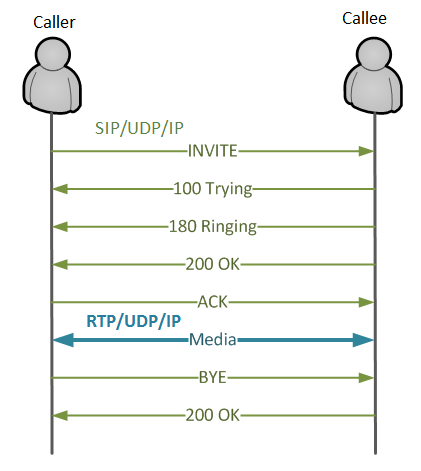
Arrows mean transmitted packets; "SIP/UDP/IP" means SIP-protocol data encapsulated into UDP and IP packet, in other words SIP packet transmitted by means of UDP and IP protocol. "RTP/UDP/IP" bold bidirectional arrow means multiple audio packets with voice data transmitted between caller and callee in two ways. The voice audio data is encoded by codec, encapsulated into RTP and transmitted by means of UDP and IP protocol.

Arrows mean transmitted packets; "SIP/UDP/IP" means SIP-protocol data encapsulated into UDP and IP packet, in other words SIP packet transmitted by means of UDP and IP protocol. "RTP/UDP/IP" bold bidirectional arrow means multiple audio packets with voice data transmitted between caller and callee in two ways. The voice audio data is encoded by codec, encapsulated into RTP and transmitted by means of UDP and IP protocol.
Encapsulation and structure of packets
Encapsulation in IP packets is a way how the data inside packets is organised: one upper-level protocol is nested inside another lower-level protocol.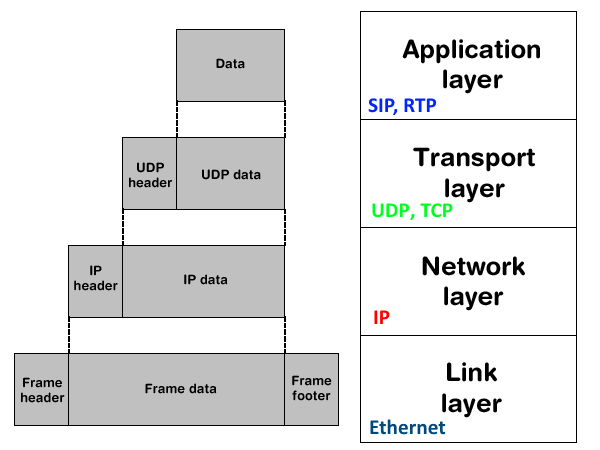
The next picture displays captured packet (sniffed, recorded packet data) by wireshark software tool.
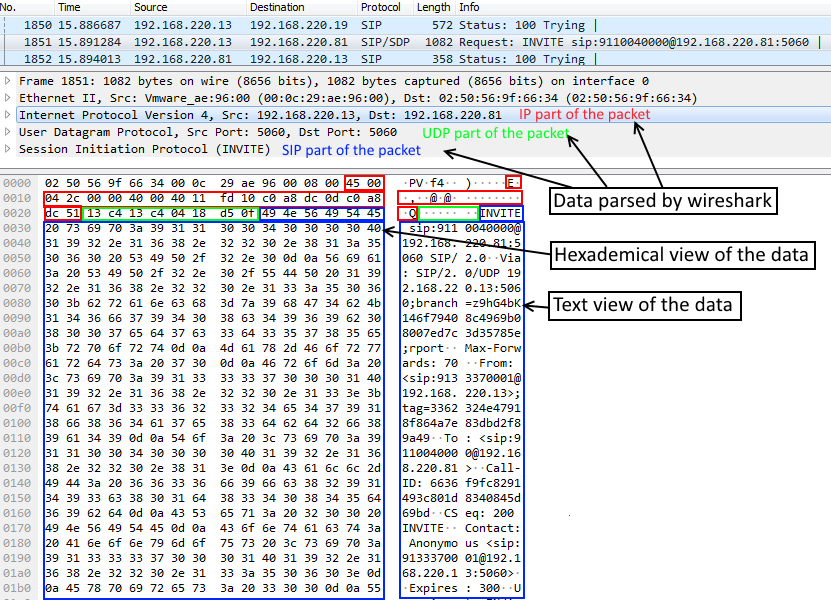
Protocols used for VoIP
Network protocol analyser software tool "Wireshark"
Before you continue with the protocols, please download and install wireshark - free and open source software tool.
It is necessary for VoIP troubleshooting and understanding network protocols.
The wireshark is able to record (sniff, capture) packets from network adapter, save them to file (.pcap, .pcapng), parse captured packets and display them in user-friendly way.
It also includes tools to parse, display, listen VoIP calls, RTP media streams.
To analyse a VoIP issue with Wireshark one should
- Select network adapter(s), start capture of VoIP packets. Reproduce the issue. Stop capture. The recorded packets could be exported/imported via .pcap/.pcapng files.
- Apply a display filter. Examples: "sip", "sip || rtp", "http", "tcp", "udp"
- Look into captured packets and see the sequence, timestamp and contents of packets
- Analyse captured VoIP call(s) (Menu - Telephony - VoIP calls)
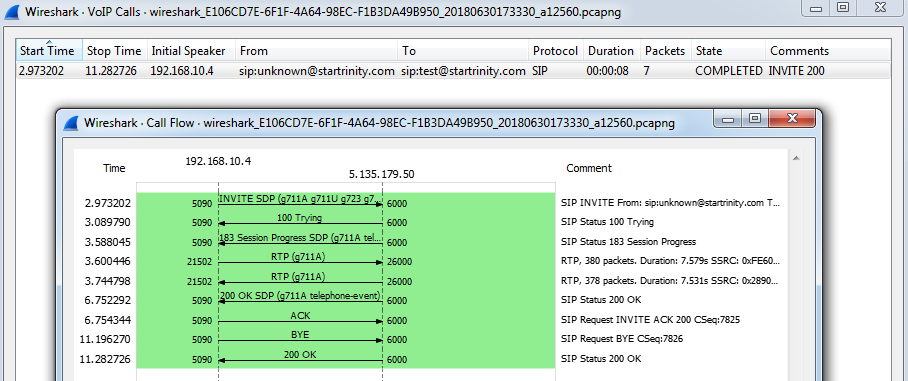
- Analyse captured RTP streams (Menu - Telephony - RTP - RTP Streams)
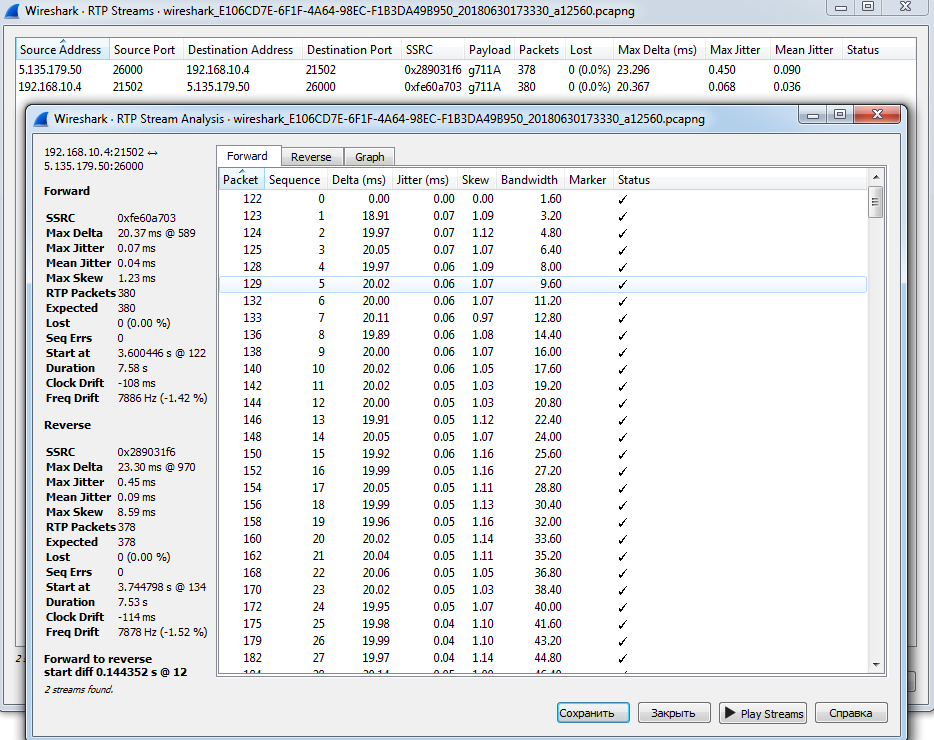
Task: please do all above things yourself: record any network activity (e.g. you can visit HTTP or HTTPS website and record it in wireshark).
You can use sample pcap file with SIP and RTP packets, single VoIP call.
The VoIP troubleshooting is complex; it requires deep understanding of protocols.
IP protocol (IP)
The Internet protocol (IP) is designed to send data packets across IP networks from source host to destination host.
The source and destination hosts both have IP address.
There are 2 most popular versions of the IP protocol: version 4 and version 6. In 2018 most widely used version is still version 4;
in the IP v.4 the address includes 32 bits and is written as 4 numbers (bytes) from 0 to 255 separated by dot, example: 192.168.0.1.
In IP v.6 the address includes 128 bits, written as 8 groups of 4 hexadecimal digits with the groups being separated by colons, example:
2018:0db8:0000:0042:0000:8a2e:0370:5678.
Here is a task to check your new skills:
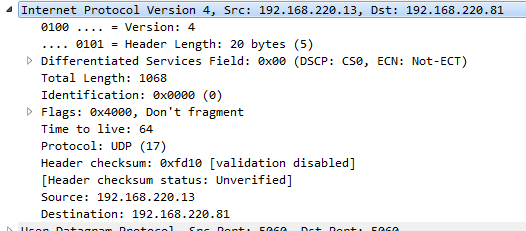
Please download this pcap file,
open it in wireshark and see what is source IP address and what is destination IP address of the single packet inside the file.
If you are unable to do it, please contact us and we will clarify this chapter.
As you can see in wireshark, IP protocol data in the packet (also called IP header) has many fields, most important are "Source", "Destination".
The "Differentiated Services Field" (includes DSCP bits) is used to prioritise VoIP traffic in IP routers.
Tasks with this file:
- See what are source and destination IP addresses of the first packet in file (SIP INVITE packet)
- See what is "Differentiated Services Field" of the first INVITE packet
- See what are IP addresses of RTP packets
- See what is "Differentiated Services Field" of the all RTP packets. Is there any pattern?
- See what is average time period (in milliseconds) between consequent RTP packets going from one source IP address to another
- See what is size of RTP packet, what is size of largest and smallest SIP packet
- See what is size of IP header
Transport protocols: User Datagram Protocol (UDP)
The UDP is designed to send data over IP protocol and UDP header contains fields "Source port" and "Destination port".
The port is a 16-bit integer having values from 0 to 65535.
Multiple applications running on source and destination host at the same time use different port numbers;
the port number identifies application which is linked (bound) to the port.
Standard port number for SIP protocol is 5060; for RTP protocol port numbers are assigned dynamically.
The UDP protocol has no means to control delivery of packets from source to destination, so the packets could be lost in IP network.
Small packet loss (below 2%) is normally handled by SIP and RTP.
Tasks with this file:
- See what is source and destination UDP port number for both SIP and RTP packets in the file
Transport protocols: Transmission Control Protocol (TCP)
In some cases VoIP calls go over Transmission Control Protocol (TCP). In other words same SIP packet data can be encapsulated into either TCP or UDP packets.
The TCP protocol header contains source and destination port numbers as UDP, it also contains fields used to control guaranteed delivery of packets.
TCP protocol provides guaranteed delivery of packets in same order from source to destination, it retransmits lost packets unlike UDP protocol.
On the other hand TCP adds extra delay for setting up connection, increasing Post-dial delay (PDD).
Besides the guaranteed delivery of data, use of TCP instead of UDP for VoIP means
- Better passing through IP routers (NAT, firewalls): TCP is used for HTTP and HTTPS web browsing and it works everywhere
- Better security: source IP address in TCP can not be spoofed
- SIPS: encryption of SIP data using TLS method (similar to HTTPS encryption)
- Stateful processing of IP packets, no possibility of lightweight stateless SIP proxy.
Task: open this file to see which TCP ports are used by caller and called endpoints.
Note: wireshark does not automatically recognize TCP packets in this file as SIP. Please select TCP packet, click "Decode As" - enter "SIP" in table field "Current" - OK
The TCP protocol introduces concepts of client, server and connection.
Client initializes TCP connection to server using TCP SYN packet; the connection is ended with TCP FIN packet.
Default server-side TCP port number for SIP is 5060; client-side TCP port number is selected randomly.
Note: wireshark does not automatically recognize TCP packets in this file as SIP. Please select TCP packet, click "Decode As" - enter "SIP" in table field "Current" - OK
Session Initiation Protocol (SIP)
The SIP is most widely used protocol for VoIP calls. It defines specific format of messages (SIP packets) and their sequence to make calls over IP networks.
The SIP messages are carried by means of UDP, TCP, or TLS/TCP (it is called SIPS).
A typical sequence of SIP messages during a VoIP call (SIP call flow diagram) is displayed in beginning of the book, here we show it one more time:

In next chapters we will describe the SIP trace in detail.

- INVITE packet (request from endpoint A to endpoint B) means initiation of call: "A wants to make new call to B"
- 100 Trying packet (response from B to A to INVITE) means confirmation of INVITE packet delivery: "B received the INVITE". 100 means response code
- 180 Ringing packet (response from B to A to INVITE) means indication of ringing state: "Phone B started to make rings". At ths time caller (A) starts to hear ringback tone. 180 means response code
- 200 OK packet (response from B to A to INVITE) means indication of answer (connection, start of billing): "Phone B answered to the call". 200 means response code
- ACK packet (from B to A) means confirmation of 200 OK packet delivery: "A received the 200 OK"
- BYE packet (request from A to B) means termination of call: "Phone A ends the call"
- 200 OK packet (response from B to A to BYE) means confirmation of BYE packet delivery: "B received the BYE"
Task: open this file in wireshark, go to "Telephony - VoIP calls" in menu and see SIP call flow diagram for the recorded VoIP call.
Other possible scenarios of VoIP calls:
- Call is ended by B after answer
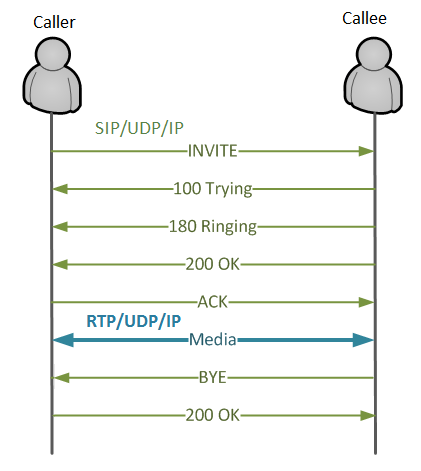
- Difference from previous flow is initiator of BYE packet
Task: open this file in wireshark, see which party (A or B, caller or callee) ended the call with BYE. - Call is ended by A before answer
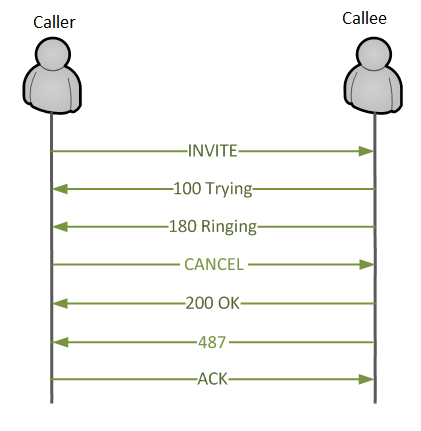
- Caller party (endpoint A) sends SIP packet "CANCEL" before connection - means "A ends the call before answer"
- Called party (endpoint B) responds to CANCEL with "200 OK" - means "B confirms receiving of CANCEL"
- Called party (endpoint B) responds to initial INVITE with "487 Request Terminated" - means "B confirms ending of call". 487 means response code
- Caller party (endpoint A) sends ACK to 487 packet - means "A confirms receiving of 487"
- Call is rejected by B (ended before answer)
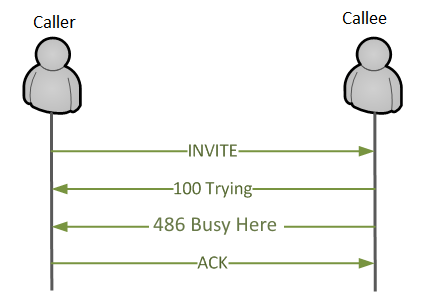
- Called party (endpoint B) responds to initial INVITE with "486 Busy Here" - means "B rejects the call with status = busy". 486 means response code
- Caller party (endpoint A) sends ACK to 486 packet - means "A confirms receiving of 486"
- Normal call flow (same as on first diagram) but with audio ringtone coming from B (can be ringback tone or music)
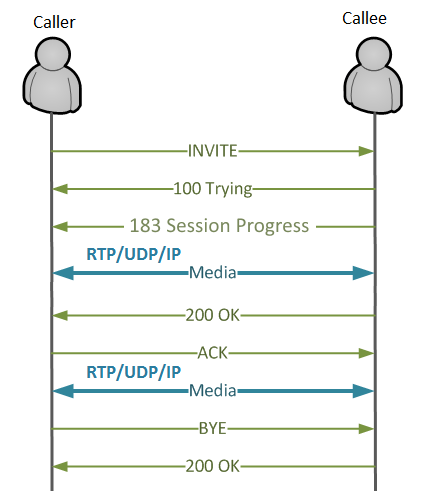
- Called party (endpoint B) responds to INVITE with "183 Session Progress" which means initiation of audio channel between A and B
- RTP media packets (audio signal) are sent between endpoints after "183", before "200 OK" (answer signal), it is called early media. Note that it is bidirectional audio stream, but it does not mean that SIP servers always pass early media from A to B. It depends on every particular softswitch. From our experience we see that most softswitches really pass early media from caller to called party in early media, before start of billing. It is safe for caller-side software because caller does not pay for early media RTP traffic.
SIP response codes
In this book we publish only most needed information about SIP, here is list of most popular response codes. Full list of SIP response codes is in RFC3261,
- 100 Trying - confirmation about receiving INVITE request
- 180 Ringing - indication of ringing phone and ringback tone
- 183 Session Progress - set up of early media (sound coming from destination with custom ringback tone before answer, during call setup)
- 200 OK - answer of the call, connection between A and B endpoints
- 302 Moved Temporarily - redirection of call to another destiantion
- 400 Bad Request - indication of incorrect format (malformed request packet). Usually the malformed packets are sent by hackers. Normally the 400 response is received if endpoints have different understanding of SIP packet format and syntax (e.g. if made by different vendors)
- 401 Unauthorized - it is actually request of another INVITE with encrypted user/password credentials
- 403 Forbidden - means that the caller has no right to make call (invalid user name or password, invalid source IP address)
- 404 Not Found - usually means wrong number format or call to non-existent extension in PBX
- 401 Proxy Authentication Required - it is actually request of another INVITE with encrypted user/password credentials. Same as 401, but sent by SIP servers
- 408 Request Timeout - means that UAC did not receive any response from UAS after series of INVITE retransmissions. Usually happens when destination server is down, when sending call to wrong IP address and port, when INVITE is blocked by firewall
- 486 Busy Here - destination is busy (usually busy by another call)
- 487 Request Terminated - usually follows after CANCEL SIP packet, when call is cancelled, ended before answer
- 488 Not Acceptable Here - usually means incompatible codecs between UAC and UAS
- 500 Internal Server Error - some internal error happened in the UAS, usually indicates a bug in VoIP server, or malformed INVITE request
- 503 Service Not Available - usually means temporarily overload: UAS can not accept more calls at this time
- 603 Decline - means generic declining for various reasons
Task: see SIP response code in this file
SIP trace
SIP trace is a series of captured/recorded SIP packets, SIP packet data represented as text. The SIP trace is necessary element for VoIP troubleshooting. When something goes wrong with your phone system, the first thing to look at is SIP trace. SIP trace and pcap recordings provide evidence of VoIP issues.
SIP messages contain request/status line (red), headers (blue) and body (green) (format of body is defined by protocol SDP). Here is sample SIP trace:
SIP messages for Call-ID 524c3ea2fdd1401ab4a90c940b073359
17:42:22.442 [+0,00ms] [TX] INVITE to 5.135.179.50:6000
INVITE sip:123456@startrinity.com SIP/2.0
Via: SIP/2.0/UDP 192.168.10.4:5090;rport;branch=z9hG4bKPjefcc1928b9d44bf68b202f5674f15b9c
Max-Forwards: 70
From: sip:unknown@startrinity.com;tag=d03ca0a253134ecc82c17a89e4b31e45
To: sip:123456@startrinity.com
Contact: <sip:unknown@192.168.10.4:5090>
Call-ID: 524c3ea2fdd1401ab4a90c940b073359
CSeq: 17970 INVITE
Allow: INFO, PRACK, SUBSCRIBE, NOTIFY, REFER, INVITE, ACK, BYE, CANCEL, UPDATE
Supported: 100rel, timer
User-Agent: StarTrinity.SIP 2018-06-14 19.29 UTC
Session-Expires: 72000;refresher=uas
Content-Type: application/sdp
Content-Length: 291
v=0
o=- 3739369344 3739369344 IN IP4 192.168.10.4
s=o3.proxy.stream0
c=IN IP4 192.168.10.4
t=0 0
m=audio 21504 RTP/AVP 8 0 4 18 101
a=rtpmap:8 PCMA/8000
a=rtpmap:0 PCMU/8000
a=rtpmap:4 G723/8000
a=rtpmap:18 G729/8000
a=sendrecv
a=rtpmap:101 telephone-event/8000
a=fmtp:101 0-15
============================================================end of message=================
17:42:22.532 [+90,26ms] [RX] Trying from 5.135.179.50:6000
SIP/2.0 100 Trying
Via: SIP/2.0/UDP 192.168.10.4:5090;rport=5090;received=87.117.173.127;branch=z9hG4bKPjefcc1928b9d44bf68b202f5674f15b9c
Call-ID: 524c3ea2fdd1401ab4a90c940b073359
From: <sip:unknown@startrinity.com>;tag=d03ca0a253134ecc82c17a89e4b31e45
To: <sip:123456@startrinity.com>
CSeq: 17970 INVITE
Supported: 100rel, timer
Content-Length: 0
============================================================end of message=================
17:42:22.542 [+100,16ms] [RX] Session Progress from 5.135.179.50:6000
SIP/2.0 183 Session Progress
Via: SIP/2.0/UDP 192.168.10.4:5090;rport=5090;received=87.117.173.127;branch=z9hG4bKPjefcc1928b9d44bf68b202f5674f15b9c
Call-ID: 524c3ea2fdd1401ab4a90c940b073359
From: <sip:unknown@startrinity.com>;tag=d03ca0a253134ecc82c17a89e4b31e45
To: <sip:123456@startrinity.com>;tag=e5316920762f4d01b4618882a3fbcad4
CSeq: 17970 INVITE
Supported: 100rel, timer
Contact: <sip:123456@5.135.179.50:6000>
Allow: INFO, PRACK, SUBSCRIBE, NOTIFY, REFER, INVITE, ACK, BYE, CANCEL, UPDATE
Server:
Content-Type: application/sdp
Content-Length: 251
v=0
o=- 3739358524 3739358524 IN IP4 5.135.179.50
s=i2.proxy.stream0
c=IN IP4 5.135.179.50
t=0 0
m=audio 26000 RTP/AVP 8 101
a=rtcp:26001 IN IP4 5.135.179.50
a=rtpmap:8 PCMA/8000
a=sendrecv
a=rtpmap:101 telephone-event/8000
a=fmtp:101 0-15
============================================================end of message=================
17:42:25.584 [+3 142,67ms] [RX] Service Unavailable from 5.135.179.50:6000
SIP/2.0 503 Service Unavailable
Via: SIP/2.0/UDP 192.168.10.4:5090;rport=5090;received=87.117.173.127;branch=z9hG4bKPjefcc1928b9d44bf68b202f5674f15b9c
Call-ID: 524c3ea2fdd1401ab4a90c940b073359
From: <sip:unknown@startrinity.com>;tag=d03ca0a253134ecc82c17a89e4b31e45
To: <sip:123456@startrinity.com>;tag=e5316920762f4d01b4618882a3fbcad4
CSeq: 17970 INVITE
Supported: 100rel, timer
Allow: INFO, PRACK, SUBSCRIBE, NOTIFY, REFER, INVITE, ACK, BYE, CANCEL, UPDATE
Server:
Content-Length: 0
============================================================end of message=================
17:42:25.584 [+3 142,70ms] [TX] ACK to 5.135.179.50:6000
ACK sip:123456@startrinity.com SIP/2.0
Via: SIP/2.0/UDP 192.168.10.4:5090;rport;branch=z9hG4bKPjefcc1928b9d44bf68b202f5674f15b9c
Max-Forwards: 70
From: sip:unknown@startrinity.com;tag=d03ca0a253134ecc82c17a89e4b31e45
To: sip:123456@startrinity.com;tag=e5316920762f4d01b4618882a3fbcad4
Call-ID: 524c3ea2fdd1401ab4a90c940b073359
CSeq: 17970 ACK
Content-Length: 0
============================================================end of message=================
===============================saved by StarTrinity SIP Tester at 2018-06-30 18:27:45======
You can see INVITE request sent by UAC, multiple responses sent by UAS (100 Trying, 183 Session Progress, 503 Service Unavailable).
SIP Request Line INVITE sip:123456@startrinity.com SIP/2.0 means request type = "INVITE" (making a VoIP call),
SIP protocol version = "2.0" (the only one version used, as we see in 2018), and destination SIP URI = "sip:123456@startrinity.com".
The URI in SIP is simular to URL in HTTP, it specifies target for the request. "sip:" or "sips:" here define protocol type,
"123456" is called number (telephone number of B endpoint).
17:42:22.442 [+0,00ms] [TX] INVITE to 5.135.179.50:6000
INVITE sip:123456@startrinity.com SIP/2.0
Via: SIP/2.0/UDP 192.168.10.4:5090;rport;branch=z9hG4bKPjefcc1928b9d44bf68b202f5674f15b9c
Max-Forwards: 70
From: sip:unknown@startrinity.com;tag=d03ca0a253134ecc82c17a89e4b31e45
To: sip:123456@startrinity.com
Contact: <sip:unknown@192.168.10.4:5090>
Call-ID: 524c3ea2fdd1401ab4a90c940b073359
CSeq: 17970 INVITE
Allow: INFO, PRACK, SUBSCRIBE, NOTIFY, REFER, INVITE, ACK, BYE, CANCEL, UPDATE
Supported: 100rel, timer
User-Agent: StarTrinity.SIP 2018-06-14 19.29 UTC
Session-Expires: 72000;refresher=uas
Content-Type: application/sdp
Content-Length: 291
v=0
o=- 3739369344 3739369344 IN IP4 192.168.10.4
s=o3.proxy.stream0
c=IN IP4 192.168.10.4
t=0 0
m=audio 21504 RTP/AVP 8 0 4 18 101
a=rtpmap:8 PCMA/8000
a=rtpmap:0 PCMU/8000
a=rtpmap:4 G723/8000
a=rtpmap:18 G729/8000
a=sendrecv
a=rtpmap:101 telephone-event/8000
a=fmtp:101 0-15
============================================================end of message=================
17:42:22.532 [+90,26ms] [RX] Trying from 5.135.179.50:6000
SIP/2.0 100 Trying
Via: SIP/2.0/UDP 192.168.10.4:5090;rport=5090;received=87.117.173.127;branch=z9hG4bKPjefcc1928b9d44bf68b202f5674f15b9c
Call-ID: 524c3ea2fdd1401ab4a90c940b073359
From: <sip:unknown@startrinity.com>;tag=d03ca0a253134ecc82c17a89e4b31e45
To: <sip:123456@startrinity.com>
CSeq: 17970 INVITE
Supported: 100rel, timer
Content-Length: 0
============================================================end of message=================
17:42:22.542 [+100,16ms] [RX] Session Progress from 5.135.179.50:6000
SIP/2.0 183 Session Progress
Via: SIP/2.0/UDP 192.168.10.4:5090;rport=5090;received=87.117.173.127;branch=z9hG4bKPjefcc1928b9d44bf68b202f5674f15b9c
Call-ID: 524c3ea2fdd1401ab4a90c940b073359
From: <sip:unknown@startrinity.com>;tag=d03ca0a253134ecc82c17a89e4b31e45
To: <sip:123456@startrinity.com>;tag=e5316920762f4d01b4618882a3fbcad4
CSeq: 17970 INVITE
Supported: 100rel, timer
Contact: <sip:123456@5.135.179.50:6000>
Allow: INFO, PRACK, SUBSCRIBE, NOTIFY, REFER, INVITE, ACK, BYE, CANCEL, UPDATE
Server:
Content-Type: application/sdp
Content-Length: 251
v=0
o=- 3739358524 3739358524 IN IP4 5.135.179.50
s=i2.proxy.stream0
c=IN IP4 5.135.179.50
t=0 0
m=audio 26000 RTP/AVP 8 101
a=rtcp:26001 IN IP4 5.135.179.50
a=rtpmap:8 PCMA/8000
a=sendrecv
a=rtpmap:101 telephone-event/8000
a=fmtp:101 0-15
============================================================end of message=================
17:42:25.584 [+3 142,67ms] [RX] Service Unavailable from 5.135.179.50:6000
SIP/2.0 503 Service Unavailable
Via: SIP/2.0/UDP 192.168.10.4:5090;rport=5090;received=87.117.173.127;branch=z9hG4bKPjefcc1928b9d44bf68b202f5674f15b9c
Call-ID: 524c3ea2fdd1401ab4a90c940b073359
From: <sip:unknown@startrinity.com>;tag=d03ca0a253134ecc82c17a89e4b31e45
To: <sip:123456@startrinity.com>;tag=e5316920762f4d01b4618882a3fbcad4
CSeq: 17970 INVITE
Supported: 100rel, timer
Allow: INFO, PRACK, SUBSCRIBE, NOTIFY, REFER, INVITE, ACK, BYE, CANCEL, UPDATE
Server:
Content-Length: 0
============================================================end of message=================
17:42:25.584 [+3 142,70ms] [TX] ACK to 5.135.179.50:6000
ACK sip:123456@startrinity.com SIP/2.0
Via: SIP/2.0/UDP 192.168.10.4:5090;rport;branch=z9hG4bKPjefcc1928b9d44bf68b202f5674f15b9c
Max-Forwards: 70
From: sip:unknown@startrinity.com;tag=d03ca0a253134ecc82c17a89e4b31e45
To: sip:123456@startrinity.com;tag=e5316920762f4d01b4618882a3fbcad4
Call-ID: 524c3ea2fdd1401ab4a90c940b073359
CSeq: 17970 ACK
Content-Length: 0
============================================================end of message=================
===============================saved by StarTrinity SIP Tester at 2018-06-30 18:27:45======
Types of SIP packets
SIP Requests also known as SIP methods, SIP request methods. Most popular SIP request types:
The SIP response packets are is sent back to requesting endpoint and contain SIP response code and optional error details in SIP headers:
If a packet is lost somewhere between the endpoints A or B (UDP protocol does not gaurantee delivery of packets), the SIP packets are retransmitted.
- INVITE - most widely used SIP request, means request to make new VoIP call from UAC to UAS. When the INVITE is sent after connection (after "200 OK response") it usually means change of audio codec, putting call on hold, or sending/receiving fax
- ACK - confirmation that response was delivered to UAS
- BYE - ends current VoIP call after answer, sent by UAS or UAC
- CANCEL - ends a call before answer, sent by UAC
- REGISTER - sent from SIP phone user-agent to SIP server to register the phone to specific extension (i.e. internal phone number)
- REFER - starts call transfer procedure: e.g. A makes call, B answers, understands that call needs to be passed to C and sends request to B: "please transfer to C"
- We have listed only most popular SIP request types, see others in RFC3261
The SIP response packets are is sent back to requesting endpoint and contain SIP response code and optional error details in SIP headers:
SIP/2.0 500 Internal Server Error
Via: SIP/2.0/UDP 9.45.33.11:5081;branch=z9hG4bK-10854-1-0
From: sipp <sip:111@9.45.33.11:5081>;tag=10854SIPpTag001
To: sut <sip:222@9.43.29.50:5060>;tag=38404-23F2
Date: Tue, 05 Feb 2013 05:49:37 GMT
Call-ID: 1-10854@9.45.33.11
CSeq: 1 INVITE
Allow-Events: telephone-event
Warning: 399 9.43.29.50 "Transcoder Not Configured"
Server: Cisco-SIPGateway/IOS-15.3.20130202.123643.
Reason: Q.850;cause=16
Content-Length: 0
In this example "Warning" header gives details about the error and "Reason" header gives information about PSTN release code.
Via: SIP/2.0/UDP 9.45.33.11:5081;branch=z9hG4bK-10854-1-0
From: sipp <sip:111@9.45.33.11:5081>;tag=10854SIPpTag001
To: sut <sip:222@9.43.29.50:5060>;tag=38404-23F2
Date: Tue, 05 Feb 2013 05:49:37 GMT
Call-ID: 1-10854@9.45.33.11
CSeq: 1 INVITE
Allow-Events: telephone-event
Warning: 399 9.43.29.50 "Transcoder Not Configured"
Server: Cisco-SIPGateway/IOS-15.3.20130202.123643.
Reason: Q.850;cause=16
Content-Length: 0
If a packet is lost somewhere between the endpoints A or B (UDP protocol does not gaurantee delivery of packets), the SIP packets are retransmitted.
SIP headers
A header in SIP packet has a simple format: [name]: [value]. SIP headers are separated by line breaks. Most widely used SIP headers are- From header indicates identity of caller, usually contains Caller ID (ANI, CLI, A number). Also contains unique "tag" set by UAC
- To header identifies recipient of the call, usually contains Called ID (called number, B number). Also contains unique "tag" set by UAS
- Via header saves information about proxy servers - server IP address and port - to pass response from UAS back to UAC via same set of proxy servers
- Record-Route header is optionally inserted by proxy servers to route subsequent SIP requests for the same SIP call
- Call-ID header identifies SIP call along with "From" and "To" headers
- Contact header specifies IP address and port to be used by peer SIP endpoints for subsequent SIP requests for the same SIP call
- CSeq header contains a decimal number which increases by 1 with every subsequent SIP request within the same SIP call, with the exception of CANCEL and ACK requests which use the CSeq number of corresponding INVITE request
- Server header indicates model, software/firmware version of UAS
- User-Agent header indicates model, software/firmware version of UAC
- Content-Length header as you will read later, INVITE and "200 OK" packets usually contain encapsulated SDP protocol data with information about RTP audio streams. This header specifies size of encapsulated SDP (or other) data
- Content-Type header specifies type of encapsulated data. Equals to "application/sdp" in case of encapsulated SDP
- Allow header lists set of SIP requests supported by user agent which generated the SIP message
- Supported header specifies set of supported SIP extensions by user agent which generated the SIP message
- Require header specifies set of required SIP extensions by user agent which generated the SIP message
- Session-Expires header - part of RFC 4028 (Session Timers) SIP extension - specifies max. interval to refresh SIP call with keep-alive packet (the RFC3261 standard does not define way to abort hang calls)
- Expires header specifies lifetime of corresponding SIP request
- WWW-Authenticate, Authorization headers are used for digest authentication
Tasks:
Registration
Registration in SIP means passing information about user agent to server, it is implemented with REGISTER. It means "Hello SIP server, here are my contact details for extension number 456: IP address 1.2.3.4, SIP port 5060". Without registration SIP phones must know IP addresses of every destination phone; with registration the IP addresses are stored by SIP server, also known as SIP registrar server. Her is example SIP trace for the registration process:
SIP messages for Call-ID 64b10daa51dd4c5a9d6038a43163b22d
14:32:00.599 [+0,00ms] [TX] REGISTER to 5.135.179.50:6000
REGISTER sip:startrinity.com:6000 SIP/2.0
Via: SIP/2.0/UDP 192.168.10.4:5090;rport;branch=z9hG4bKPj609d6772ba754dcab9cba92bcb34be69
Max-Forwards: 70
From: <sip:100@startrinity.com>;tag=aef6297c37914f69832efc2c44c980aa
To: <sip:100@startrinity.com>
Call-ID: 64b10daa51dd4c5a9d6038a43163b22d
CSeq: 22151 REGISTER
Allow: INFO, PRACK, SUBSCRIBE, NOTIFY, REFER, INVITE, ACK, BYE, CANCEL, UPDATE
Contact: <sip:100@192.168.10.4:5090>
User-Agent: StarTrinity.SIP 2018-06-14 19.29 UTC
Expires: 3600
Content-Length: 0
============================================================end of message=================
14:32:00.674 [+74,84ms] [RX] Unauthorized from 5.135.179.50:6000
SIP/2.0 401 Unauthorized
Via: SIP/2.0/UDP 87.117.173.127:5090;rport=5090;received=87.117.173.127;branch=z9hG4bKPj609d6772ba754dcab9cba92bcb34be69
Call-ID: 64b10daa51dd4c5a9d6038a43163b22d
From: <sip:100@startrinity.com>;tag=aef6297c37914f69832efc2c44c980aa
To: <sip:100@startrinity.com>
CSeq: 22151 REGISTER
WWW-Authenticate: Digest realm="*",nonce="6ab702ae1b742592",opaque="66982f5173f64308",algorithm=md5
Content-Length: 0
============================================================end of message=================
14:32:00.674 [+74,88ms] [TX] REGISTER to 5.135.179.50:6000
REGISTER sip:startrinity.com:6000 SIP/2.0
Via: SIP/2.0/UDP 192.168.10.4:5090;rport;branch=z9hG4bKPjcfb02f366c7f435ba7991cbb13b9497c
Max-Forwards: 70
From: <sip:100@startrinity.com>;tag=aef6297c37914f69832efc2c44c980aa
To: <sip:100@startrinity.com>
Call-ID: 64b10daa51dd4c5a9d6038a43163b22d
CSeq: 22152 REGISTER
Allow: INFO, PRACK, SUBSCRIBE, NOTIFY, REFER, INVITE, ACK, BYE, CANCEL, UPDATE
Contact: <sip:100@192.168.10.4:5090>
User-Agent: StarTrinity.SIP 2018-06-14 19.29 UTC
Expires: 3600
Authorization: Digest username="100", realm="*", nonce="6ab702ae1b742592", uri="sip:startrinity.com:6000", response="abd79c866205325d0511a95b1e5f5087", algorithm=md5, opaque="66982f5173f64308"
Content-Length: 0
============================================================end of message=================
14:32:00.758 [+158,50ms] [RX] OK from 5.135.179.50:6000
SIP/2.0 200 OK
Via: SIP/2.0/UDP 87.117.173.127:5090;rport=5090;received=87.117.173.127;branch=z9hG4bKPjcfb02f366c7f435ba7991cbb13b9497c
Call-ID: 64b10daa51dd4c5a9d6038a43163b22d
From: <sip:100@startrinity.com>;tag=aef6297c37914f69832efc2c44c980aa
To: <sip:100@startrinity.com>
CSeq: 22152 REGISTER
Contact: sip:100@87.117.173.127:5090;expires=3600
Content-Length: 0
============================================================end of message=================
===============================saved by StarTrinity SIP Tester at 2018-07-02 14:32:12======
As you can see in the SIP trace, first REGISTER request sent by UAC 192.168.10.4 to UAS 5.135.179.50 means resitration of extension 100 at SIP server startrinity.com on SIP port 6000.
The UAC sends its IP address in Contact header: Contact: <sip:100@192.168.10.4:5090>.
"Expires" SIP header equals to 3600 means that the registration entry should be valid for 3600 seconds -
in 60 minutes the registrar server should clear the registration entry if not received new REGISTER requests for this extension.
REGISTER request with "Expires: 0" means unregistration.
14:32:00.599 [+0,00ms] [TX] REGISTER to 5.135.179.50:6000
REGISTER sip:startrinity.com:6000 SIP/2.0
Via: SIP/2.0/UDP 192.168.10.4:5090;rport;branch=z9hG4bKPj609d6772ba754dcab9cba92bcb34be69
Max-Forwards: 70
From: <sip:100@startrinity.com>;tag=aef6297c37914f69832efc2c44c980aa
To: <sip:100@startrinity.com>
Call-ID: 64b10daa51dd4c5a9d6038a43163b22d
CSeq: 22151 REGISTER
Allow: INFO, PRACK, SUBSCRIBE, NOTIFY, REFER, INVITE, ACK, BYE, CANCEL, UPDATE
Contact: <sip:100@192.168.10.4:5090>
User-Agent: StarTrinity.SIP 2018-06-14 19.29 UTC
Expires: 3600
Content-Length: 0
============================================================end of message=================
14:32:00.674 [+74,84ms] [RX] Unauthorized from 5.135.179.50:6000
SIP/2.0 401 Unauthorized
Via: SIP/2.0/UDP 87.117.173.127:5090;rport=5090;received=87.117.173.127;branch=z9hG4bKPj609d6772ba754dcab9cba92bcb34be69
Call-ID: 64b10daa51dd4c5a9d6038a43163b22d
From: <sip:100@startrinity.com>;tag=aef6297c37914f69832efc2c44c980aa
To: <sip:100@startrinity.com>
CSeq: 22151 REGISTER
WWW-Authenticate: Digest realm="*",nonce="6ab702ae1b742592",opaque="66982f5173f64308",algorithm=md5
Content-Length: 0
============================================================end of message=================
14:32:00.674 [+74,88ms] [TX] REGISTER to 5.135.179.50:6000
REGISTER sip:startrinity.com:6000 SIP/2.0
Via: SIP/2.0/UDP 192.168.10.4:5090;rport;branch=z9hG4bKPjcfb02f366c7f435ba7991cbb13b9497c
Max-Forwards: 70
From: <sip:100@startrinity.com>;tag=aef6297c37914f69832efc2c44c980aa
To: <sip:100@startrinity.com>
Call-ID: 64b10daa51dd4c5a9d6038a43163b22d
CSeq: 22152 REGISTER
Allow: INFO, PRACK, SUBSCRIBE, NOTIFY, REFER, INVITE, ACK, BYE, CANCEL, UPDATE
Contact: <sip:100@192.168.10.4:5090>
User-Agent: StarTrinity.SIP 2018-06-14 19.29 UTC
Expires: 3600
Authorization: Digest username="100", realm="*", nonce="6ab702ae1b742592", uri="sip:startrinity.com:6000", response="abd79c866205325d0511a95b1e5f5087", algorithm=md5, opaque="66982f5173f64308"
Content-Length: 0
============================================================end of message=================
14:32:00.758 [+158,50ms] [RX] OK from 5.135.179.50:6000
SIP/2.0 200 OK
Via: SIP/2.0/UDP 87.117.173.127:5090;rport=5090;received=87.117.173.127;branch=z9hG4bKPjcfb02f366c7f435ba7991cbb13b9497c
Call-ID: 64b10daa51dd4c5a9d6038a43163b22d
From: <sip:100@startrinity.com>;tag=aef6297c37914f69832efc2c44c980aa
To: <sip:100@startrinity.com>
CSeq: 22152 REGISTER
Contact: sip:100@87.117.173.127:5090;expires=3600
Content-Length: 0
============================================================end of message=================
===============================saved by StarTrinity SIP Tester at 2018-07-02 14:32:12======
Digest authentication
As you can see in previous SIP trace (with REGISTER), first request is rejected with status "401 Unauthorized" and WWW-Authenticate header, it is called digest challenge. The WWW-Authenticate SIP header contains nonce and opaque values which are used by UAC along with user name and password to send second INVITE request. The second INVITE request contains Authorization header with digest response, it is used by UAS to verify user name and password. If user name and password are correct, UAS sends "200 OK" response, otherwise it sends "403 Unauthorized" response.SIP extensions
Extensions of SIP protocol are defined by additional RFC standard documents (beyond RFC3261),
you can find them here.
Most important SIP extensions are
- 100rel extension defines PRACK method to provide reliable delivery of provisional SIP responses.
It is fully described in RFC3262.
The PRACK packets are sent in response to 18x provisional responses via chain of SIP proxy servers from UAC to UAS:

Here is example SIP call flow for PRACK:
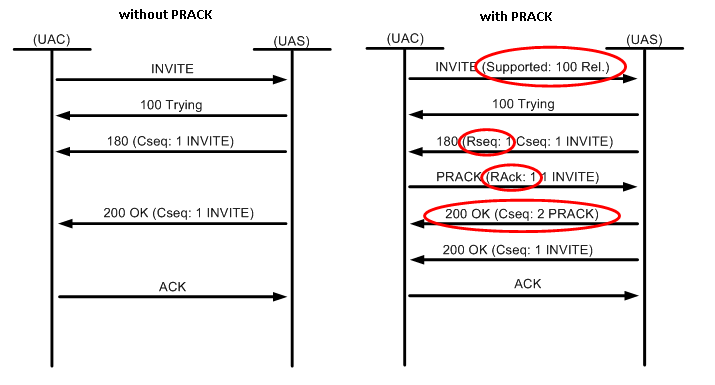
Without the PRACK, 18x SIP responses could be lost in IP network between UAS and UAC, it means no ringback tone played to caller. With PRACK, 18x SIP response is retransmitted by UAS if it does not receive PRACK from UAC. - timer extension defines a keep-alive mechanism for SIP calls, it is described in RFC4068 (Session Timers). The keep-alive packets are sent as re-INVITE or UPDATE SIP packets between UAC and UAS; if the keep-alive packet is not received within session interval, UAC or UAS considers call as hang (dead) and drops the call. Without the session timer extension there could appear hang calls, existing on one SIP UA and already destroyed on another SIP UA. Such situation can happen if internet connection drops between UAC and UAS during end of call, and BYE packet gets lost.
Real-time Transport Protocol (RTP)
The RTP transfers audio or video stream between user agents over UDP protocol.
RTP media stream goes from source IP address and UDP port to destination IP address and UDP port.
In most cases RTP streams in VoIP are bidirectional.
Task: open this file in wireshark, see what is source and destination IP addresses and UDP ports for RTP streams. How many RTP streams do you see in the file?
RTP is defined by RFC3550 IETF standard document; its usage for VoIP is described in RFC3551.
RTP packets (encapsulated in UDP) contain following important fields:
- SSRC (synchronization source identifier) - a randomly selected 32-bit identifier for source of RTP stream, usually also unique for many VoIP calls and does not change during call (SSRC may be changed only in rare cases, for example when call is put on hold). The SSRC is used to detect RTP collisions (when multiple RTP streams are sent to same UDP port)
- Sequence number - 16-bit integer number which is incrememented by 1 with every subsequent transmitted RTP packet. Is used in jitter buffer on receiver side to detect and compensate lost and delayed packets. Initial value for the sequence number is usually assigned randomly.
- Timestamp - 32-bit field, usually randonly initialized like sequence number and incremented with every transmitted RTP frame by number of transmitted samples. For example for audio RTP packets with sample rate 8kHz and containing 20ms audio in every RTP packets, RTP timestamp gets incremented by 8000 / 1000 * 20 = 160 samples. For a MPEG video RTP packet with sample rate 90000Hz and 30FPS it would be 90000/30 = 3000 samples per frame. For codecs with variable bit rate (VBR) it is more complex. Note: Timestamp and Sequence number values may jump, and VoIP software must be able to handle the jumps.
- Payload - encapsulated voice/video data, or DTMF digit. The media stream is splitted into small frames of 10..50 milliseconds and transmitted over RTP packets. The duration of the frame is called packet time, it is configurable in VoIP software. The audio/video data is encoded with a codec. Type of the codec is specified by payload type and SDP.
- Payload type - 7-bit integer (0-127), specifies format of encapsulated payload: encoded audio/video or DTMF digit.
RTP streams are used to transfer DTMF digits (when caller presses a key on phone during call), it is defined by RFC2833.
Range of payload types (0..127) is divided into static payload types (0..95) and dynamic payload types (96..127),
for more information please refer to RFC3551.
Most common static payload types / audio codecs are:
- 0 / G.711 mU-law (also known as PCMU) and
- 8 / G.711 A-law (also known as PCMA) - stateless audio codec with simplest implementation. There is one-to-one mapping between uncompressed 16-bit PCM samples and compressed 8-bit G.711 samples; the mapping is different for mu-law and a-law. A-law is used in EU; mu-law is used in US. The G.711 codec is used in TDM networks. Sample frequency is 8 kHz (8000 audio samples per second). Here word stateless means that encoding/decoding of an audio sample does not use information about previously encoded/decoded audio samples. Bandwidth of G.711 codec is 64kbit/s.
- 18 / G.729 - stateful 8kbit/s audio codec, royalty-free since 2017 (patent has expired).
G.729 has been extended with annexes G.729A and G.729B:
- G.729A has a medium complexity, and is compatible with original G729. It provides a slightly lower voice quality
- G.729B extends G.729 with silence suppression, and is not compatible with the previous versions. The G729B introduces CNG (comfort noise generator) packets with smaller size, in this way reducing bandwidth when there is no sound
- G.729AB extends G729A with silence suppression, and is only compatible with G729B
- 3 / GSM - GSM codec, stateful. Is rarely used
- 4 / G.723 - G.723 codec, stateful. Is rarely used
INVITE sip:123456@5.6.7.8;user=phone SIP/2.0 SIP request line: method = "INVITE" (make call)
Via: SIP/2.0/UDP 1.2.3.4:5061;rport;branch=z9hG4bK-3767867992-3776019369-1982645923-1415686538 various SIP headers
From: <sip:srct_tel_num@1.2.3.4:5061;user=phone>;tag=910826072-3776019369-1982645923-1415686538
To: <sip:123456@5.6.7.8;user=phone>
Call-ID: 581a4a72a97b11e1a3c62c768aa96154@1.2.3.4
CSeq: 1 INVITE
Contact: <sip:srct_tel_num@1.2.3.4:5061;user=phone>
Content-Type: application/sdp SIP header indicating type of encapsulated content: SDP = Session Description Protocol (what kind of data is carried inside the SIP INVITE packet?)
Allow: ACK, BYE, CANCEL, INFO, INVITE, OPTIONS, REFER, REGISTER, UPDATE
Max-Forwards: 70
User-Agent: StarTrinity v.4.4.0-19a
Content-Length: 714 size of encapsulated content
here starts the encapsulated content, SDP offer from caller side (SIP UAC)
v=0
o=- 1338288302 1338288302 IN IP4 1.2.3.4
s=-
c=IN IP4 1.2.3.4 IP address where UAC waits for RTP packets from UAS. when UAC is behind NAT, and there is no SIP ALG, it is internal (LAN) IP address, and it should be ignored by UAS
t=0 0
m=audio 35018 RTP/AVP 18 103 0 8 4 3 96 102 list of codecs (payload types) supported by UAC. 0, 3, 4, 18 are static, others are dynamic
a=rtpmap:18 G729/8000 rtpmap entry: what is payload type (PT) 18? it is mapped to codec G.729, sample frequency 8000 Hz
a=fmtp:18 annexb=nofmtp entry: what are parameters of payload type 18? annexb=no means that it is G.729 or G.729A, not G.729B. CNG packets are not expected by UAC for PT=18
a=rtpmap:103 G729/8000 PT=103 is declared similarly to previous PT=18,
a=fmtp:103 annexb=yes with support of CNG packets (it is G729 annex B)
a=rtpmap:0 PCMU/8000 PT=0 is G.711U, sample frequency is 8000Hz
a=rtpmap:8 PCMA/8000 PT=8 is G.711A, sample frequency is 8000Hz
a=rtpmap:4 G723/8000 PT=4 is G.723, sample frequency is 8000Hz
a=fmtp:4 annexa=yes
a=rtpmap:3 GSM/8000 PT=3 is GSM, sample frequency is 8000Hz
a=rtpmap:96 speex/8000 PT=96 is Speex, sample frequency is 8000Hz
a=fmtp:96 mode=3;vbr=off
a=rtpmap:102 telephone-event/8000 PT=102 means DTMF digits. UAC expects to receive DTMF digits inside RTP stream from UAS with payload type 102
a=fmtp:102 0-15
a=sendrecv UAC offers bidirectional RTP stream in this SDP - Marker bit - could be is set to 1 with every start of new RTP stream fragment (for example when RTP stream is interrupted by DTMF digit). The marker bit is used as a flag to re-initialize jitter buffer.
Task: open this file in wireshark, see RTP codec, packet time in samples, packet time in milliseconds, SSRC identifiers.
RTP streams in Wireshark
The Wireshark tool provides great functionality to analyse RTP streams in recorded VoIP traffic.
You can view RTP streams in Wireshark using menu Telephony - RTP - RTP Streams.

The filtered RTP packets could be analysed to check their payload type, timestamp, sequence field, the payload itself as hex bytes (see screenshot).
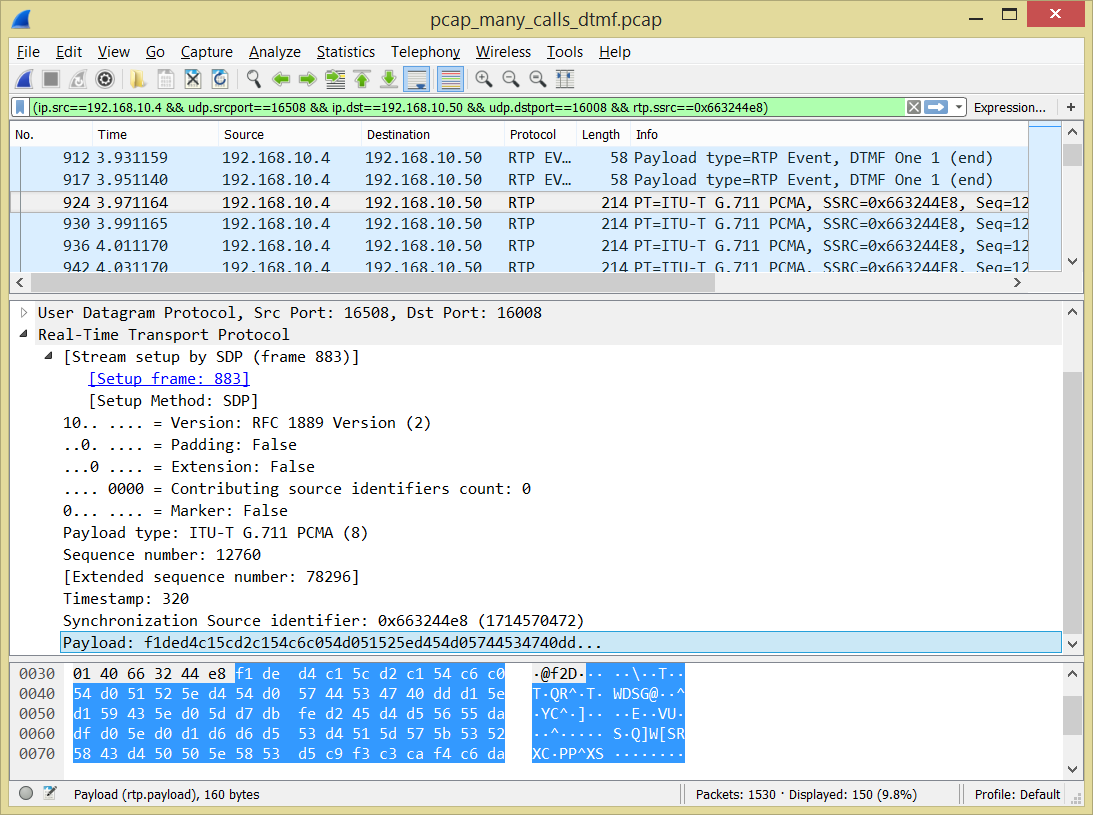
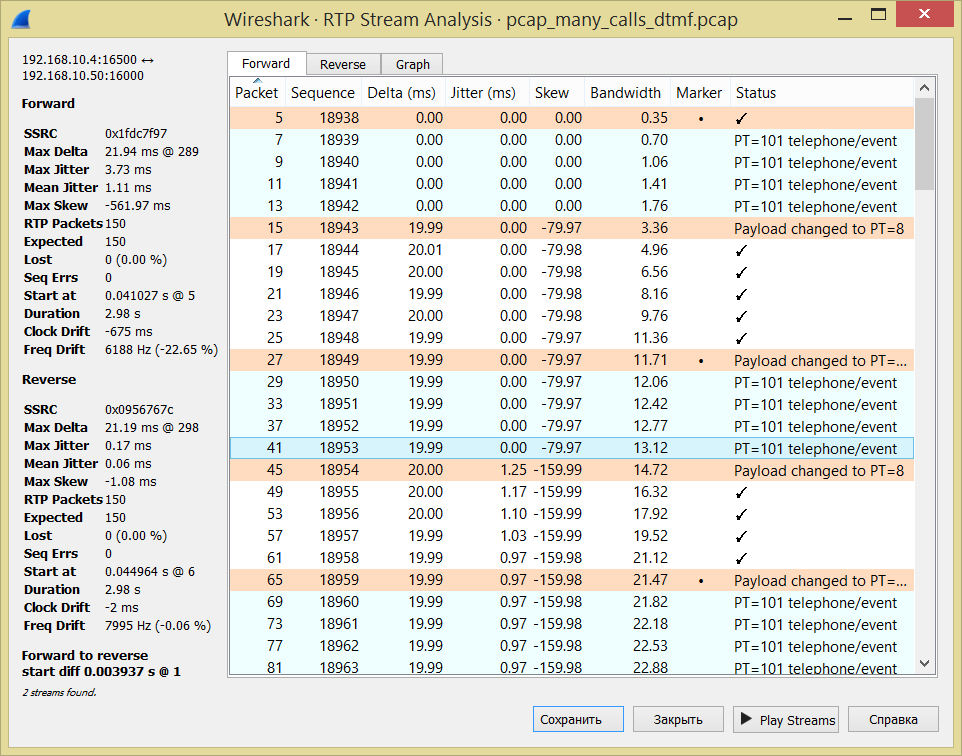
and listened via sound card:
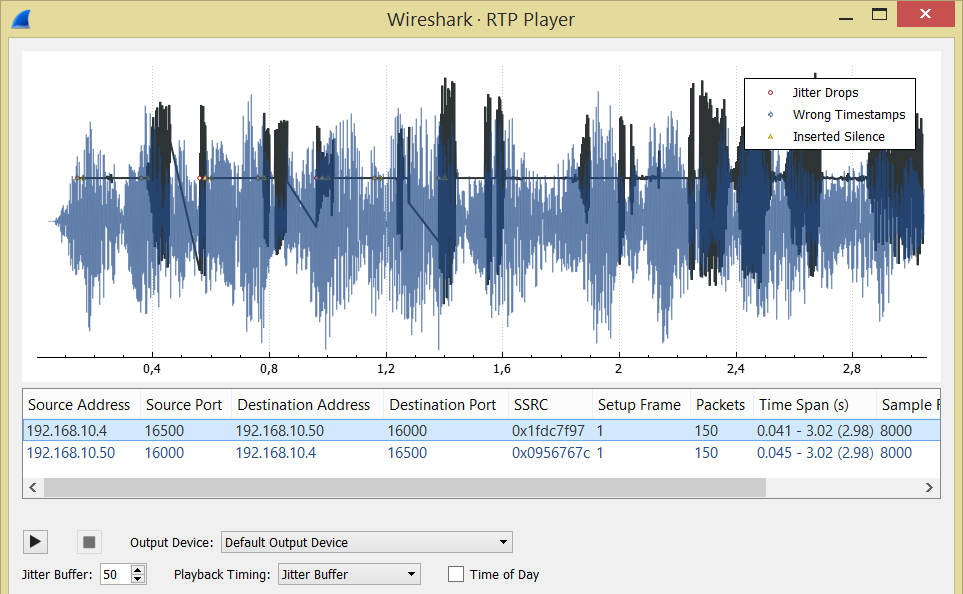
If you need to link RTP streams to VoIP calls, it is possible with Wireshark's VoIP call flow diagram: menu item Telephony - VoIP calls - (select a call) - Flow sequence:
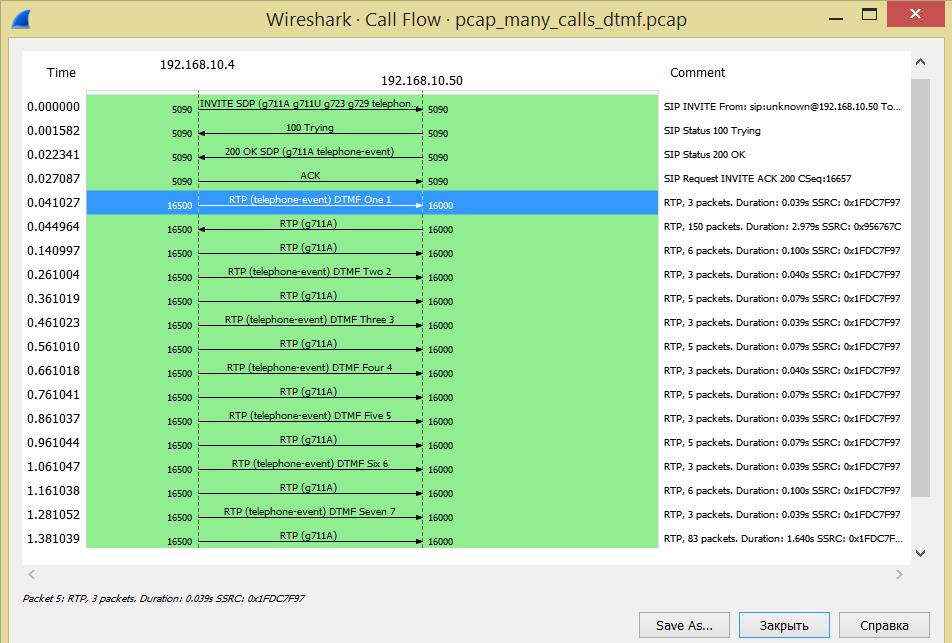
Clicking on RTP stream in the call flow selects corresponding RTP packet inside main window area.
todo: what is delta and skew? What are normal values? What if skew is too high: desync of RTP clock. in TDM circuits there was a special wire for this 8khz synchronization. and in voip - no. and it is a potential issue, not covered by RTP and SIP.
Task: open this file, see
Multiple RTP streams are selectable with a mouse (left button click).
Button "prepare filter" allows you to view only selected RTP streams in main window area.
It is useful when you have many VoIP calls recorded and need to debug only one call:- How many VoIP calls captured in the file, what are dialed destination numbers, what are caller ID's
- How many RTP streams captured in the file
- What are source and destination IP addresses and UDP port numbers

The filtered RTP packets could be analysed to check their payload type, timestamp, sequence field, the payload itself as hex bytes (see screenshot).

Tasks with same file: see
The selected RTP stream(s) could be analysed (button "Analyse") to see some great details (see screenshot)- Is there any pattern in marker bit?
- What is size of DTMF payload, size of G.711 payload?
- How many RTP packets transmit every single DTMF digit? What is duration of DTMF digits (in milliseconds and samples)?
- Which party sends DTMF: UAC or UAS?

and listened via sound card:

If you need to link RTP streams to VoIP calls, it is possible with Wireshark's VoIP call flow diagram: menu item Telephony - VoIP calls - (select a call) - Flow sequence:

Clicking on RTP stream in the call flow selects corresponding RTP packet inside main window area.
Task with same file: what DTMF sequence(s) are played within the recorded VoIP calls? All same or different?
Encrypted RTP: SRTP (unfinished)
The content is not ready yet. ZRTPRTCP protocol (unfinished)
The content is not ready yetSession Description Protocol (SDP) (unfinished)
See SDP example #1
Types of VoIP issues (unfinished)
Types of VoIP issues by symptom
- Failed calls
- Calls dropped after connection
- no response to 200 OK - firewall on UAC side [sample sip trace]
- 200 OK sent to wrong destination. UAC behind NAT
- failed re-invite or UPDATE (ping) request (done by session timer)
- Audio quality issues
- No audio
- One-way audio
- Bad audio quality
- High round-trip delay
- Firewall misconfiguration
- Router or server may require reboot to apply new firewall settings
- Bugs in VoIP software
VoIP quality indicators (unfinished)
Multiple-calls quality indicators (unfinished)
Indicators applicable for VoIP route, VoIP traffic, VoIP provider, VoIP originator.- Answer seizure ratio (ASR). Averaging interval
- Average call duration (ACD). Averaging interval
- Post-dial delay (PDD)
Single-call quality indicators: audio quality (unfinished)
- RTP max delta
- RTP delta
- RTP jitter
- RTP packet loss
- RTP packet loss burst rate
- RTP packet loss in jitter buffer caused by jitter
- RTP packet loss in jitter buffer caused by RTP clock skew
- G.107 MOS
- PESQ MOS
- Confidence score (0-100%)
VoIP troubleshooting methods (unfinished)
- Understanding components of the VoIP system and interaction between them
- Short-time experiments
- Making test call or registering phone to the server and sniffing traffic with wireshark
- Running VoIP readiness test - we have free demo VoIP readiness test with VoIP Status
- Long-time experiments
- Continuous active monitoring (with test calls) - we have a software product VoIP Status
- Test audio quality by verifying audio sent from an IVR number via your VoIP route
- Test internet connection with continuous web-based HTTP tests: continuous bandwidth test and continuous online latency test
- Continuous active monitoring (with test calls) - we have a software product VoIP Status
VoIP software bugs (draft)
Bug is a symptom of abnormal, unexpected behaviour of the VoIP software. For example:
- Rejected VoIP call in case when the call should not be rejected
- Bad performance: high RTP jitter and high post-dial and answer delays
- VoIP software crash causing dropping of all current calls: major error or memory leak. The crash could be permanent (when one has to restart the VoIP software manually) or temporary, when the software gets recovered by itself automatically drop of current call after some duration invalid audio: silence, one-way, invalid IVR lost CDR records or corrupt CDR files invalid billing calculation
- Code review, making experiment in developer's mind
- Reproduce the bug in debugger, within ide integrated development environment (IDE), put breakpoint, see values of variables and code flow path. Pros: easiest way to see what happens in the code, using the IDE. Cons: is not possible when the bug happens only on customer's site, remotely, and remote debugging is not possible. In many cases the reproducing of customer's environment on developer side is possible, but complex. .. run software in IDE but access customer's environment from developer's machine via internet
- Reproduce the bug on customer's side, analyse logs
- For regression bugs: trace at which version bug appears. go back in history of versions to see the difference
Real VoIP troubleshooting cases
The real cases are reported with permission of our customers and readers of the book.
Case #1: Mitel 6873i SIP phone registration at 3CX IP PBX
The issue has been reported by Telin, cloud IP PBX service provider, reseller of 3CX:
Submit my case
We have new Mitel 6873 handsets (SIP phones) deployed at a client's location and there appears to be an issue with the phones connect back to a 3CX server at the same time when another softphone connects to the same extension. It creates a contact name mismatch and mitel phone unregisters.
We have been working with mitel for a couple weeks and they are pointing their finger at 3CX and 3CX pointing finger back at them.
Troubleshooting steps:
- Clarify the situation with Telin. What happens in terms of SIP protocol
- At the same time both Mitel phone and 3CX softphone send REGISTER to 3CX server to same extension. Mitel phone sends via UDP. 3CX softphone sends via tunnel.
- The Mitel phone receives 200 OK response to the REGISTER, this response contains multiple "Contact" headers.
- The Mitel phone displays an error related to registration, and calls do not work. When 3CX softphone is not registered, everything is fine.
Mitel phone analyses contact header which is received from server in response to register. It does not accept the syntax.
Incorrect:
Contact: <sip:003@127.0.0.1:50195;transport=TCP;rinstance=1-xs7ou4dgsbv7tg5.ntvyho6kmku6kv-a;ob;inst="D7FCE2">;reg-id=1;+sip.instance="<urn:uuid:00000000-0000-0000-0000-00008340d0fa>";expires=74
Correct:
Contact: <sip:003@127.0.0.1:50195;transport=TCP>;rinstance=1-xs7ou4dgsbv7tg5.ntvyho6kmku6kv-a;ob;inst="D7FCE2";reg-id=1;+sip.instance="<urn:uuid:00000000-0000-0000-0000-00008340d0fa>";expires=74
The problem seems to be in incorrect contact header in the 200 OK for the softphones. Below is one of the sipphone contact headers in NotWorking trace. In this contact header the > sign is added in an incorrect place which takes some of the feature parameters like rinstance inside the sip: part. I have shown the incorrect and correct way (based on how Mitel phone processes the contact header). - Clarify the situation ourselves by making the experiment one more time, sniffing working and non-working REGISTER cases.
- Working case: one mitel phone registers and receives "200 OK" response to REGISTER with following contact header:
Contact: "Mitel Phone"<sip:701@10.0.6.39:5060>;+sip.instance="<urn:uuid:00000000-0000-1000-8000-00085D5C0866>";expires=120 - Not working case: one 3CX softphone is registered, at the same time one more (mitel) phone send REGISTER with contact header
Contact: "Mitel Phone" <sip:701@10.0.6.39:5060>;+sip.instance="<urn:uuid:00000000-0000-1000-8000-00085D5C0866>";expires=0and receives "200 OK" response to REGISTER with following 3 contact headers:
Contact: "Mitel Phone"<sip:701@10.0.6.39:5060>;+sip.instance="<urn:uuid:00000000-0000-1000-8000-00085D5C0866>";expires=120We see that the response is not correct. It muct contain only 2 contact headers, not 3, since only 2 phones are registered to one extension
Contact: "Mitel Phone"<sip:701@127.0.0.1:5060;rinstance=1-hkg2btlqkdv6ydfaixt62uwrre1zz4sd;inst="b98a8bbf">;expires=62
Contact: <sip:701@127.0.0.1:5488;rinstance=f27cf6aeccdab97f>;expires=55
- Working case: one mitel phone registers and receives "200 OK" response to REGISTER with following contact header:
- At this point we know that we have a multi-component system and an issue related to one or multiple components, or to combination of components. It is helpful to understand which component causes the issue.
So we make a new experiement with a new system containing different components: 3CX PBX, Mitel phone and Polycom phone: we replace 3CX softphone by Polycom phone to see what happens. This is what we observe:
- In this combination it works. All phones registered successfully
- Contact headers in "200 OK" response to REGISTER:
Contact: "Mitel Phone"<sip:701@10.0.6.39:5060>;+sip.instance="<urn:uuid:00000000-0000-1000-8000-00085D5C0866>";expires=120We see that the 3CX PBX server responded correctly with 2 contact headers
Contact: <sip:701@127.0.0.1:5488;rinstance=f27cf6aeccdab97f>;expires=72
Contact: <sip:007@10.0.6.8>;methods="INVITE, ACK, BYE, CANCEL, OPTIONS, INFO, MESSAGE, SUBSCRIBE, NOTIFY, PRACK, UPDATE, REFER"and receivesContact: <sip:007@10.0.6.8:5060>;methods="INVITE, ACK, BYE, CANCEL, OPTIONS, INFO, MESSAGE, SUBSCRIBE, NOTIFY, PRACK, UPDATE, REFER";expires=120- this is also correct, 2 contact headers in response, and it works in this combination too.
Contact: <sip:007@127.0.0.1:5488;rinstance=8d481b0693d20404>;expires=106 - Based on the experiments we make conclusion and suggest possible ways towards solution
- 3CX PBX is wrong in sending 3 Contact headers. Further action: submit bug report to 3CX team including SIP trace
- Mitel phone could have a configurable setting whether to verify Contact headers in response to REGISTER or not. Further actions: try to downgrade to old firmware version which does not verify contact headers in response, or request a new version with the configurable setting
Chapters to be written in future
- components of voip and telephone systems
- jitter buffer. impact of JB: higher RTT. JB affects only RX RTP stream, not TX
- codec: encoder, decoder
- RTP clock. RTP clock skew. Synchronization in PSTN
- PLC (for G.711)
- SIP endpoints (User Agents)
- pc phones
- mobile dialers
- hardware phones
- VoIP-PSTN gateways: SIP-PRI, SIP-SIGTRAN-SS7, SIP-GSM, SIP-bluetooth
- IP Network, other traffic running along with VoIP traffic. Congestions causing packet loss. Duplicate packets
- IP routers, IP switches
- Network Address Translation (NAT). port triggering. port forwarding
- SIP going through NAT. Symmetric SIP behaviour on SIP servers
- RTP going through NAT. Symmetric RTP behaviour on SIP servers
- SIP ALG (application-level gateway)
- DSCP, prioritization, VoIP QoS, IP SLA
- firewalls
- VPN and other tunnels
- Synchronous Bandwidth Optimizers (SBOs)
- Internet Service Providers. Static IP, dynamic IP. NAT, firewall
- Hosting providers. Amazon, Azure, NAT, firewall
- SIP servers
- Routing-billing engine
- Proxy servers
- Softswitches
- Session Border Controllers (SBCs)
- Heterogenous SIP implementations
- SIP attacks
- Fraudulent VoIP traffic
- IP PBX servers
- voip route providers, sip trunks. direct routes. PDD, ASR, ACD. FAS, international bypass
- DID providers. 1-800 lines. Packet loss and audio quality issues. Call center audio quality monitoring
- Call generators and receivers. Looped generated traffic.
- Public Switched Telephone Network (PSTN).
- TDM. E1, PRI, SS7 trunks.
- Routing. OPC, DPC.
- Vulnerabilities and fraud scenarios
- network impacts. jitter, packet loss. Burst rate, G.107 e-model. RTT. report via rtcp within 1 hop. non-visibility after sbc - need of full audio path testing.
- cases of troubleshooting. 1 works in one case, doesnt work in another case. comparison method.
- intermittent bugs.
- software tools and services for VoIP tests.
- active testing, passive monitoring - startrinity, sipp, gl
- continuous monitoring, one-time tests - voipmonitor, startrinity
- test automation. unit tests, unit test frameworks.
- voip routes testing. i-test.net, chekmyroutes. cli delivery
- penetration test tools
- IVR audio verification / 2-way audio verification test tools
- test cases by object of testing
- ip network. nat. bandwidth, dscp
- softswitch, pbx,cucm
- gateway sip-pstn
- call center
- PSTN public switched telephone network
- conference servers
- ivr servers. ivr testing audio verification
- voip routes. cli delivery. uptime. fas, overbilling. voip-OTT routes
- test cases by symptom
- always happens or intermittent issue?
- ways to increase probability of intermittent issue. stress testing. complexity of test cases. difference between test case and real voip calls.
- audio issues: chopped sound, one way audio, no audio. nat issues. jitter, loss, dscp flag
- call failure:408, 503,other codes
- server memory leak
- server intermittent crashes
- server sip and rtp stack software upgrade, stability test
- test scenarios (scripts)
- unit tests with IVR audio verification
- regular dialing: same number, params from csv
- monitoring, email notifications
- SIP Security, SIP Trunking
- list of RFC documents related to SIP. general overview for every RFC. RFC3261, RFC 5359. SIP REFER, blind transfer
- VoIP fraud types
- FAS: types: IVR, LDFAS, etc. generation, detection. 200OK-ACK delay
- International bypass: OTT, GSM. Blending. CLI delivery testing. CDR profiling, filtering
- Sending dialer traffic
- Brute force attack
- Man-in-the-middle attacks
- Sending malformed SIP packets.
- DOS attacks (REGISTER, INVITE). DDOS attacks.
- UDP flooding: SIP, RTP. TCP SYN flood attack. Role of SBC's
- Weak/default passwords - brute force attacks
- IP spoofing
- Spam over IP telephone
- Toll fraud
- Vishing - Phishing over VoIP
- Missed calls with CLI = IPRN
- Traffic to IPRN while route provider is not aware of IPRN ranges
- Fraud tools
- SIPVicious
- Mr.SIP